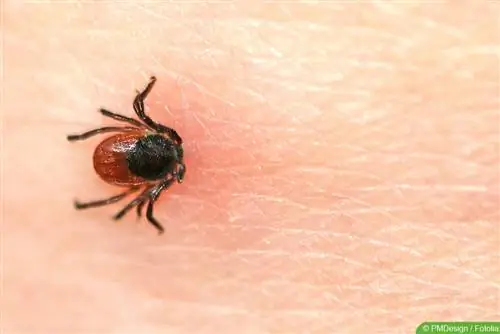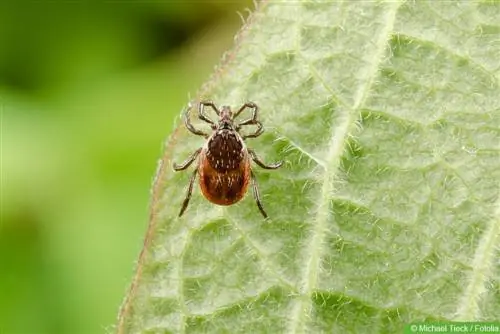- Author admin [email protected].
- Public 2023-12-17 03:39.
- Last modified 2025-06-01 06:48.
Ticks are treacherous enemies for cats that can move freely in the garden, field and forest. The tiny insects lurk patiently and almost invisibly in vegetation close to the ground in order to pounce on roaming outdoor cats and feast on their blood. The nefarious activities of the parasites raise important questions. How can I effectively protect my cat from ticks? Can the beasts be transmitted to humans? Is there a tick vaccination for humans and animals? Read well-founded answers and insightful background information in this guide.
What exactly are ticks?
Ticks are among the largest species of mites and are therefore classified as arachnids. All 900 species known to date lead a life as blood-sucking parasites, of which a total of 19 species of ticks are native to our regions. Fear and terror among cat owners are primarily caused by the common wood tick (Ixodida) and the spotted tick (Dermacentor). Other native tick species have specialized on dogs, hedgehogs or birds and rarely pose a danger to cats. The following characteristics characterize a tick:
- Body length: 2.5 to 5 mm (significantly larger when fully saturated)
- Color: dark brown, dark gray or reddish
- 8 legs, divided into recognizable limbs
- unwinged, often with a recognizable chitin shield on the back
- female ticks with stretchable exoskeleton
- Life expectancy: 2 to 3 years
- good frost tolerance

The preferred habitat is ground-level vegetation. Ticks wait patiently on grasses, perennials and small trees until a cat or a similarly suitable host comes by. Contrary to popular misconception, the insects do not jump on their victim or fall down from the tree. Rather, wooden trestles and the like can simply be removed from their waiting position.
Tip:
Please do not confuse the tick species common wood tick (Ixodes ricinus) with the destructive house tick (Hylotrupes bajulus), also known as the large woodworm. These are two completely different pest insects that require different approaches to protective measures and control.
Why is protection against ticks important?
Ticks have characteristic mouthparts designed as sophisticated biting and sucking apparatus. They pierce the epidermis and use their saliva to release an anticoagulant into the blood, which also acts as a local anesthetic. The bitten cat does not immediately notice the attack and therefore does not take any instinctive countermeasures. Fatally, dangerous pathogens enter the bloodstream with the secretion. Affected cats are at risk of allergies, infections, blood poisoning and serious diseases such as Lyme disease or meningoencephalitis (TBE). The sucking process itself can take hours or weeks if the parasite is not disturbed. Only when the tick is full of its blood meal does it drop to the ground.
Tip:
Natural and home remedies reach their limits when it comes to protecting a cat from tick bites. The well-intentioned recommendation to rub citronella, lavender or tea tree oil into your fur should fall on deaf ears. Primary tea tree oil is highly toxic to cats because they metabolize essential oils differently than dogs or other fur-bearing animals.
What protective measures are there?

The good news is: Because cats naturally groom themselves constantly, cunning ticks in their restless coats are less likely to find a target than in dogs. A velvet paw is not completely immune to vampires. So what to do? You can carefully examine the thick fur after every trip outdoors for crawling or bitten ticks. This doesn't guarantee that one or two tiny things won't slip through your fingers. You cannot vaccinate your beloved pet against ticks. The best solution to the problem is preventative protection that nips an infestation in the bud. Two methods for tick prevention on outdoor cats have proven to be effective in practice.
Spot-On Agent
Veterinary medicine refers to antiparasitic solutions that can be dripped on or rubbed on as spot-on agents. The liquid or creamy preparations are applied to an area of the skin that your cat cannot reach and therefore cannot lick off. Recommended application locations are between the shoulder blades or on the back of the neck. Spot-on products that have been proven to be effective contain toxins such as fipronil. The following products are freely available for sale in Germany:
- Frontline(R) Spot on cat, pipette with 0.5 ml solution for 2 weeks at a price starting at 15.99 euros for 3 pipettes
- Bolfo Spot-on cat, pipette with 0.5 ml solution also works against fleas at a price from 14.99 for 3 pipettes
- Lyra Pet(R) 5 x 1 ml IPERON Spot-On against ticks and fleas for the price of 13.38 euros
- bogadual(R) ANTI-PARASIT Spot-on Cream with Margosan and EBAAP at a price starting at 14.99 euros for 4 tubes
Tick collars
So that a collar effectively protects your cat against ticks, the following products contain biocides such as imidacloprid and flumethrin. Over a period of 3 to 4 months, the active ingredients are continuously released to repel and kill ticks.
- bogacare(R) ANTI-PARASITE collar for 3 months at a price of 3.99 euros per piece
- beapar tick and flea protection collar for 4 months at a price of 6.98 euros per piece (35 cm long)
- Ardap tick/flea protection collar for cats for 4 months at a price of 10.25 euros each
When purchasing, please make sure that it is a self-release collar. These straps have a predetermined breaking point and release the cat if it gets tangled on its forays.
Natural remedies don't work
Natural remedies reach their limits when it comes to protecting against ticks. In 2017, Stiftung Warentest determined in a laboratory test with test subjects that only biocidal products can protect people from ticks. In the same year, the Association for Consumer Information (VKI) - the Austrian counterpart - found that this premise can be seamlessly transferred to tick protection for cats. 20 spot-on products and collars were examined, especially for cats. Of these, 12 products with organic ingredients only act as a tick repellent. The remaining 8 products are classified as biocides and kill the parasites based on toxic substances.

The result was sobering for fans of natural remedies. All defensive organic agents failed the test. Reliable effectiveness could only be attested to the preparations containing nerve agents. In Germany, these biocides against ticks are available over the counter, whereas in Austria they require a prescription.
Tip:
All anti-tick products for dogs are completely unsuitable for cats. The chemical composition of the preparations induces life-threatening side effects in the cat's organism. Please be sure to use tick protection that is specifically suitable for cats.
Are they transferable to humans?
This question can be answered with a clear yes. The best tick treatment does not offer 100 percent protection. It cannot therefore be ruled out with certainty that your cat will be used as a tick taxi and involuntarily transport the rabble into the house. In fact, the females sometimes take many hours before deciding on a spot of skin. Until then, the pests remain mobile, tiny and difficult to locate. Veterinarians therefore recommend thoroughly checking outdoor animals for parasites every time they return. There is a risk that you will brush off a tick without noticing it. The parasites could boldly use even a simple stroking as a greeting to switch hosts to you or your children. For the woodbuck in particular, it doesn't matter whether it gets its blood meal from a human or animal host.
When is a tick vaccination advisable?
The potential transmission of ticks to humans raises the question of whether you or your family can be vaccinated against an infestation. A vaccine that fights off the parasites has yet to be invented. At least there is the possibility of getting vaccinated against the transmission of meningoencephalitis - TBE for short. When we talk about a tick vaccination, we mean a preventative vaccination against the pathogens. A lot of research has been devoted to causal treatment without any well-founded results. Once symptoms such as fever and pain appear, doctors can only alleviate the suffering. Your family doctor does not provide vaccinations for other diseases that can be transmitted by ticks, such as Lyme disease.

Not every tick is unpopular as a carrier of TBE. The all-clear can be given at this point for residents in northern Germany, as there have been no patients to complain about in these areas so far. In southern Germany, Austria and Switzerland, however, up to 50 percent of ticks carry the dreaded virus. The Standing Vaccination Commission (STIKO) in Germany, in collaboration with the Robert Koch Institute, publishes an annual bulletin with recommendations in which regions a tick vaccination makes sense. In 2019, the following federal states are considered risk areas for TBE:
- Baden-Württemberg
- Bavaria
- Hesse
- Rhineland-Palatinate
- Saarland
- Saxony
- Thuringia
Basic immunization with two vaccinations 4 weeks apart is recommended, in good time before the start of the tick season, which extends from April to November. A third tick vaccination is given after 9 to 12 months. After 3 years, a first refresher is recommended for uninterrupted protection against ticks. According to the Robert Koch Bulletin, beyond the risk areas, all people who regularly travel in forests and fields for work, such as forestry officials or farmers, should be vaccinated.
Expert advice
The experts strongly recommend that you and your family be vaccinated against meningoencephalitis even if you are planning a vacation in the above-mentioned risk areas such as Austria, Hungary or Switzerland. These countries are widely considered epidemic areas for TBE. It is important to note that you consult your doctor about the tick vaccination before a tick bite, as there is no vaccination for afterwards.






